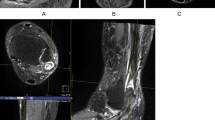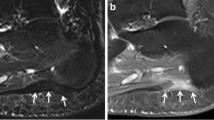Abstract
Objectives
Our goals were to quantify the reduction of the magic angle effect using short-tau inversion recovery (STIR) imaging and to determine the value of adding an axial STIR sequence to the magnetic resonance imaging ankle protocol.
Materials and methods
Axial STIR sequences were used to measure normal tendon T1 and to estimate signal loss due to the inversion recovery preparation of our clinical protocol. In addition, 102 ankles were imaged with axial fat-suppressed intermediate-weighted fast spin echo and STIR sequences. Two radiologists analyzed the tendons for signal intensity, size, abnormalities, and magic angle effect. The diagnostic value and image quality of the two sequences were compared.
Results
We calculated a 50 % reduction of signal intensity in healthy tendons on the STIR sequence at TI = 170 ms compared with TI = 0 ms, explaining the decrease in the magic angle effect. Using the STIR sequence, our study demonstrated significantly lower signal intensity within the tendons, more precise tendon size, and a lower magic angle effect compared with the standard intermediate-weighted FSE sequence (p < 0.001). Diagnostic classification of tendon abnormalities using the STIR sequences showed higher sensitivity (82.35 % vs 75.27 %) and better agreement with a reference standard than the intermediate-weighted sequences, and superior image quality (p < 0.01).
Conclusions
Axial STIR sequences reduce magic angle effects and improve visualization of ankle tendon pathology.





Similar content being viewed by others
References
Schweitzer ME, Karasick D. MRI of the ankle and hindfoot. Semin Ultrasound CT MR. 1994;15(5):410–22.
Cheung Y, Rosenberg ZS, Magee T, Chinitz L. Normal anatomy and pathologic conditions of ankle tendons: current imaging techniques. Radiographics. 1992;12(3):429–44.
Aerts P, Disler DG. Abnormalities of the foot and ankle: MR imaging findings. AJR Am J Roentgenol. 1995;165(1):119–24.
Kingston S. Magnetic-resonance imaging of the ankle and foot. Clin Sport Med. 1988;7(1):15–28.
Khoury NJ, el-Khoury GY, Saltzman CL, Brandser EA. MR imaging of posterior tibial tendon dysfunction. AJR Am J Roentgenol. 1996;167(3):675–82.
Rosenberg ZS, Beltran J, Bencardino JT. From the RSNA Refresher Courses. Radiological Society of North America. MR imaging of the ankle and foot. Radiographics. 2000;20:S153–79.
Wang XT. Normal variants and diseases of the peroneal tendons and superior peroneal retinaculum: MR imaging features. Radiographics. 2005;25:587–602.
Campbell RS, Grainger AJ. Current concepts in imaging of tendinopathy. Clin Radiol. 2001;56(4):253–67.
Mengiardi B, Pfirrmann CWA, Schöttle PB, Bode B, Hodler J, Vienne P, et al. Magic angle effect in MR imaging of ankle tendons: influence of foot positioning on prevalence and site in asymptomatic subjects and cadaveric tendons. Eur Radiol. 2006;16(10):2197–206.
Schweitzer ME, Caccese R, Karasick D, Wapner KL, Mitchell DG. Posterior tibial tendon tears - utility of secondary signs for Mr-imaging diagnosis. Radiology. 1993;188(3):655–9.
Zanetti M. Founder’s lecture of the ISS 2006: borderlands of normal and early pathological findings in MRI of the foot and ankle. Skelet Radiol. 2008;37(10):875–84.
Erickson SJ, Prost RW, Timins ME. The magic-angle effect—background physics and clinical relevance. Radiology. 1993;188(1):23–5.
Fullerton GD, Rahal A. Collagen structure: the molecular source of the tendon magic angle effect. J Magn Reson Imaging. 2007;25(2):345–61.
Erickson SJ, Cox IH, Hyde JS, Carrera GF, Strandt JA, Estkowski LD. Effect of tendon orientation on Mr imaging signal intensity—a manifestation of the magic angle phenomenon. Radiology. 1991;181(2):389–92.
Peh WCG, Chan JHM. The magic angle phenomenon in tendons: effect of varying the MR echo time. Br J Radiol. 1998;71(841):31–6.
Fullerton GD, Cameron IL, Ord VA. Orientation of tendons in the magnetic field and its effect on T2 relaxation times. Radiology. 1985;155(2):433–5.
Li T. Manifestation of magic angle phenomenon: comparative study on effects of varying echo time and tendon orientation among various MR sequences. Magn Reson Imaging. 2003;21(7):741–4.
Bydder M, Rahal A, Fullerton GD, Bydder GM. The magic angle effect: a source of artifact, determinant of image contrast, and technique for imaging. J Magn Reson Imaging. 2007;25(2):290–300.
Bydder GM, Young IR. MR imaging—clinical use of the inversion recovery sequence. J Comput Assist Tomogr. 1985;9(4):659–75.
Bydder GM, Steiner RE, Blumgart LH, Khenia S, Young IR. MR imaging of the liver using short TI inversion recovery sequences. J Comput Assist Tomogr. 1985;9(6):1084–9.
Wright P, Jellus V, McGonagle D, Robson M, Ridgeway J, Hodgson R. Comparison of two ultrashort echo time sequences for the quantification of T(1) within phantom and human Achilles tendon at 3T. Magn Reson Med. 2012;68(4):1279–84.
Du J, Pak BC, Znamirowski R, Statum S, Takahashi A, Chung CB, et al. Magic angle effect in magnetic resonance imaging of the Achilles tendon and enthesis. Magn Reson Imaging. 2009;27(4):557–64.
Gold GE, Han E, Stainsby J, Wright G, Brittain J, Beaulieu C. Musculoskeletal MRI at 3.0T: relaxation times and image contrast. AJR Am J Roentgenol. 2004;183(2):343–51.
Kingsley PB. Signal intensities and T-1 calculations in multiple-echo sequences with imperfect pulses. Concepts Magn Reson. 1999;11(1):29–49.
Kijowski R, Farber JM, Medina J, Morrison W, Ying J, Buckwalter K. Comparison of fat-suppressed T2-weighted fast spin-echo sequence and modified STIR sequence in the evaluation of the rotator cuff tendon. AJR Am J Roentgenol. 2005;185(2):371–8.
Rosenberg ZS, Cheung Y, Jahss MH, Noto AM, Norman A, Leeds NE. Rupture of posterior tibial tendon: CT and MR imaging with surgical correlation. Radiology. 1988;169(1):229–35.
Delfaut EM, Demondion X, Bieganski A, Cotten H, Mestdagh H, Cotten A. The fibrocartilaginous sesamoid: a cause of size and signal variation in the normal distal posterior tibial tendon. Eur Radiol. 2003;13(12):2642–9.
Delfaut EM, Beltran J, Johnson G, Rousseau J, Marchandise X, Cotten A. Fat suppression in MR imaging: techniques and pitfalls. Radiographics. 1999;19(2):373–82.
Acknowledgments
We would like to thank Ms Piyawan Srikhum, doctoral student at CEREG-University Paris-Dauphine for her assistance with the statistical analyses. I would also like to express a special thanks to Mr Napat Boonsaeng for his help with data processing, and for all of his suggestions during difficult times.
Author information
Authors and Affiliations
Corresponding author
Rights and permissions
About this article
Cite this article
Srikhum, W., Nardo, L., Karampinos, D.C. et al. Magnetic resonance imaging of ankle tendon pathology: benefits of additional axial short-tau inversion recovery imaging to reduce magic angle effects. Skeletal Radiol 42, 499–510 (2013). https://doi.org/10.1007/s00256-012-1550-y
Received:
Revised:
Accepted:
Published:
Issue Date:
DOI: https://doi.org/10.1007/s00256-012-1550-y




